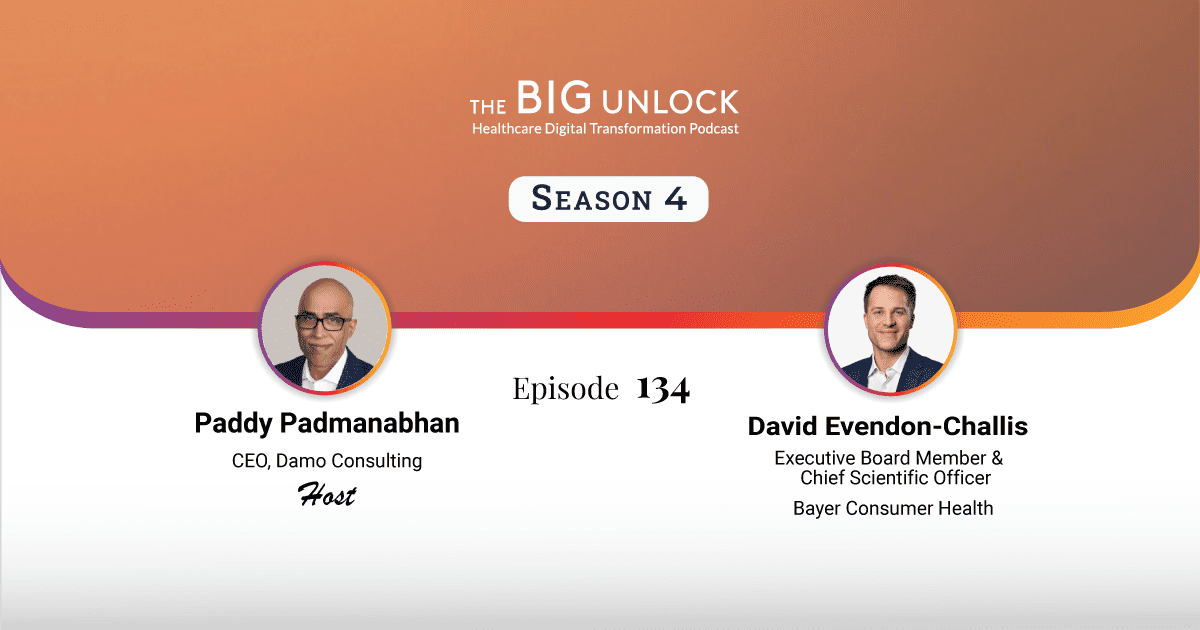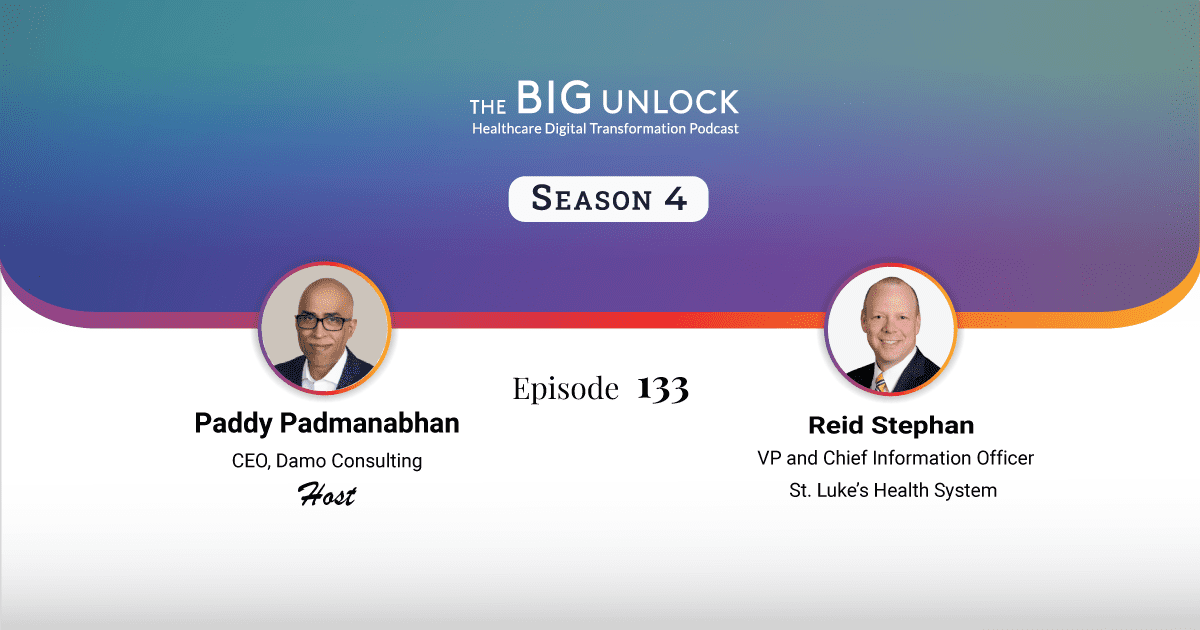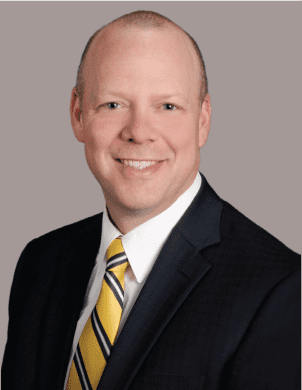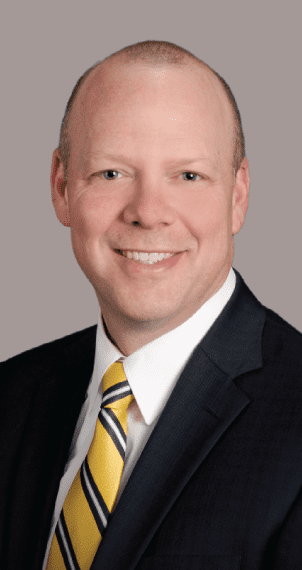Season 4: Episode #134
Podcast with David Evendon-Challis, Executive Board Member and Chief Scientific Officer, Bayer Consumer Health
"Advancing Care with Digital Health Tools: Innovations in Healthcare Technology"
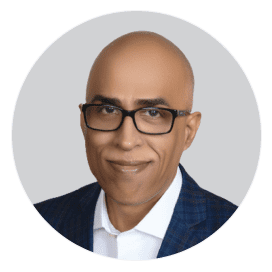 Hosted by Paddy Padmanabhan
Hosted by Paddy Padmanabhan 
Share
In this episode, David Evendon-Challis, Executive Board Member and Chief Scientific Officer at Bayer Consumer Health discusses their approach to help consumers adopt digital health tools to manage and improve their healthcare outcomes. David also explores trends driving better self-care among consumers.
Digital health tools are gaining momentum among customers and making better self-care more accessible. However, all these innovative technology solutions must seamlessly integrate into the mainstream healthcare delivery models. David believes that increased interest in health and self-care awareness, affordable healthcare technologies, and people wanting to use more technology to communicate combined will bring the perfect storm for improved health outcomes. He also talks about the current state of digital therapeutics and its relevance in improving consumer health. Take a Listen.
Show Notes |
||||
| 00:45 | About Bayer and the Consumer Health Division. | |||
| 02:08 | Self-care has become a big trend among consumers. What kind of trends are you seeing at Bayer and what is driving all this? | |||
| 04:07 | Can you give us few examples of the digital tools that will gain momentum with consumers, specifically in the U.S.? | |||
| 07:30 | How much clinically validated is the self-monitored care? It seems like there's a need to integrate all the technology innovations with mainstream healthcare delivery models. What’s your take on this? | |||
| 10:20 | What is the current state of evolution and innovation of digital therapeutics in terms of the consumer-facing devices? How are they fitting into the mainstream healthcare context? | |||
| 12:46 | Can you talk about Bayer's approach to the movement around self-care and helping consumers with the tools that they need to manage their care better? | |||
| 15:43 | How is self-care different from people just taking time-off, a vacation, go on a diet, or take some me-time? Is there a connotation that you attach to the term? | |||
| 19:30 | Where does old medicine, for instance - Ayurveda, fit in this picture? Do you see that as being a part of the self-care movement? | |||
| 24:11 | What’s your advice to our listeners, especially those who are digital health startups looking to get their product out in the market in partnership with a global company such as Bayer? | |||
About our guest
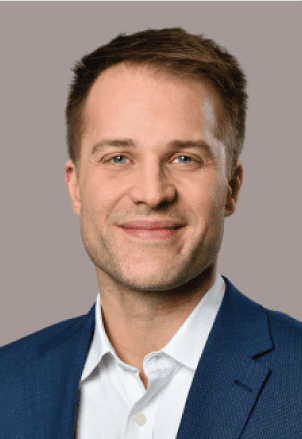
David Evendon-Challis is Head of R&D for Bayer’s Consumer Health Division and is a member of the Consumer Health Executive Committee. He is responsible for worldwide innovation and product development, from scoping and ideation through delivering innovation to the market via internal and external development.
David is a British national, with a first class Master’s degree in Biological Sciences from the University of Oxford, UK. Over the past 17 years he has worked across regulatory, communications & public affairs, sustainability and product development. He joined Bayer in January 2020 from RB where he spent eight years in R&D leadership roles of increasing responsibility - most recently heading innovation across the company’s consumer health business. Prior to this he worked at companies including Kimberly-Clark, Salterbaxter MSL and the Engine Group.
He is passionate about creating and scaling innovations that are purpose-driven, human-centric, scientifically robust, and credible.
David is married with two children. He is based at Consumer Health’s global headquarters in Basel, Switzerland.
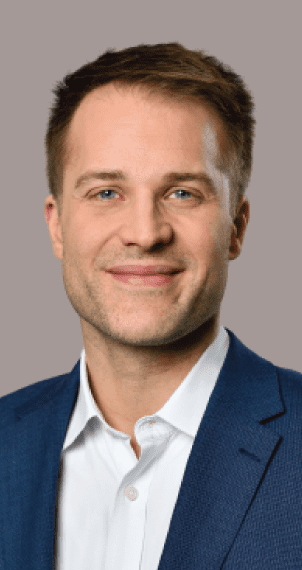
David Evendon-Challis is Head of R&D for Bayer’s Consumer Health Division and is a member of the Consumer Health Executive Committee. He is responsible for worldwide innovation and product development, from scoping and ideation through delivering innovation to the market via internal and external development.
David is a British national, with a first class Master’s degree in Biological Sciences from the University of Oxford, UK. Over the past 17 years he has worked across regulatory, communications & public affairs, sustainability and product development. He joined Bayer in January 2020 from RB where he spent eight years in R&D leadership roles of increasing responsibility - most recently heading innovation across the company’s consumer health business. Prior to this he worked at companies including Kimberly-Clark, Salterbaxter MSL and the Engine Group.
He is passionate about creating and scaling innovations that are purpose-driven, human-centric, scientifically robust, and credible.
David is married with two children. He is based at Consumer Health’s global headquarters in Basel, Switzerland.
Q: David, can you talk to us about Bayer and the Consumer Health Division?
David: Bayer has been around for a long time; longer than the Queen and I. I joined the company about three years ago. I work within consumer health, which is one of three divisions—pharmaceuticals, crop science, and consumer health.
We’re a leading player within consumer health with 170 brands of which, 15 are extremely large. We focus our innovation efforts on and work across a lot of different self-care areas—allergy cough, cold, pain, cardio, digestive health, dermatology, and supplements—so we have a broad self-care business.
Self-care has become a big trend among consumers. What are the trends you see as Chief Scientific Officer of the Consumer Health Division of Bayer? What is driving this trend?
David: We’ve been seeing, for some years, an increasing interest in a lot of people to take better care of themselves. You become more aware of the impact of things like smoking, watching your weight, exercise, eating the right fruits and vegetables etc. That has been bubbling along, but there’s not been a huge emphasis on real prevention of disease.
A lot has shifted in the last couple of years, so, we know that people want to take much better care of themselves. That’s totally been accelerated by COVID. I found some of the statistics here, super interesting. In COVID, 44% of people started using new devices to help manage their health proactively. About 90% of them had positive experiences, which I think, is extremely high. Over half of the people want to use more tech to communicate with their health care professionals and manage their health.
This isn’t a new statistic but the one that always gets me and continues to blow my mind is the 200 billion healthcare searches on Google, every year. Combining that increasing interest in health care and our ability to take care of our health and prevent disease with more affordable technologies, particularly, things that are already part of our day-to-day lives may just be the perfect storm for better prevention, better self-care. That’s what we’re seeing across the board.
Q: Can you give us one or two examples of the sort of digital tools that will gain momentum with consumers in the specific context of the United States?
David: There’s all kinds of things. You go from the very simple ones but I would still count digital tools as those that help people make decisions about which products they take.
The online health and wellness questionnaires are very basic but these are on the rise. They help people navigate what is quite a complex shelf to choose what to do, what to buy, when to use it, etc. In the U.S., we have majority stake in companies like Care/of. It’s a personalized VMS company. There has been a big rise in using that from a user’s point of view to actually get better products.
There are increasing sales of specialist devices—the things that people carry with them be it their smartphones, Fitbits, or their Apple watches. These are the things that people are starting to get better insights from, and using to manage their health more and more. I can only see that becoming more important in the future as the devices get more sophisticated and better about giving us actionable insights, if not diagnoses. These are the areas that are going to help make better self-care much, much more accessible for more people.
Take my personal favorite. At the moment, for me, sleep is important but I don’t want to wear a special sleep monitoring device. I’m interested, but not that much, in it. However, I will wear my watch to bed and check it every single morning. I will adjust my behaviors based on that, and it will add that into my daily routine. That’s critical as well, having whatever the solution technology might be, something that can seamlessly integrate into your life, and that will always be as easy to be top of mind and enable us to keep doing it. Those are the things that are going to stay.
We know that complicated, unpleasant experiences—even complying with the medication, for example—may make lots of people drop out. Making things super easy and part of people’s lives is part of this.
Q: While there’s a lot you can now do to monitor yourself and take better care simultaneously, how much of it is clinically validated? It seems like there’s a need to integrate new innovation with mainstream health care delivery models. What’s your take at Bayer?
David: I look at it from two angles one of which is, there’re some really promising technologies for things like digital therapeutics, which we’ll see is in the Rx kind of area. I’m a consumer, but I can see that being absolutely relevant for consumer health, as well. In these areas, we could have a debate, although I’m not an expert about the evidence behind some of these. But there is a lot of evidence being generated on those digital therapeutics. From that angle, there’s a huge relevance for self-care and the digital drug is actually helping people to take care and treat themselves.
When it comes to using digital biomarkers to help identify where your problems are, this isn’t just about being able to run a report and giving that to your doctor. It’s about getting better, actionable insights for you to manage your own health. Those don’t always need to be 100% perfect and accurate in order to get generalized insights that can actually help you shift your behavior in a better direction to become healthier. I think there’s absolutely a role for those kinds of things and the two may ultimately kind of meet in the middle.
In the meantime, there’s a lot of value in the more general health, personal health insights that we can get from these different technologies. They can help individuals determine when they might need to see their healthcare provider and actually dig into an issue in more detail. It’s not always the case for things like, for example, my sleep. This is about me feeling better, waking up lighter, and being able to manage my busy job, two small children etc. The kind of insights that I get from my Apple Watch and the app that I’ve purchased are bang-on for that. So, I think it depends on the need.
Q: Digital therapeutics has become almost a mainstream term, now. What is the current state of their evolution and innovation as it relates to some of these consumer-facing devices? How are they fitting into the mainstream healthcare context?
David: Within self-care, it’s coming from all different angles. There are lots of different roles. If you think about this cycle from within self-care, awareness, education, engagement, assessments, diagnosis, treatments, then, in continuing that cycle, there’s this role for different technologies within that.
I’m really interested in things like the symptoms assessment tool. We’ve been working with Ada Health and piloting with a couple of our brands around the world to see what is the role of powerful symptoms assessment to help guide people when they are in areas that are quite confusing, like irritable bowel syndrome, for example, or identifying the causes of some of your pain. Some of these day-to-day things are real issues to people. There are really important technologies that are helping very much with that part of the self-care continuum we’re seeing.
Whilst there’s absolutely going to be a role for self-selection yet the questionnaire-based approaches, complement some of the digital biomarkers which are getting better, and will continue to do so. At one point, I believe, they will become acceptable to the entire health system. In the meantime, I think they will increasingly provide great information and actionable insights.
I also think that is a role and people are increasingly accepting of drawing blood and providing saliva to actually get more detailed information about themselves. All of these pieces are coming together. Unfortunately, I don’t think we quite have the glue, which is where we, as an industry, need to work together a little bit better, because all of these component pieces are pretty much there but the system isn’t quite working seamlessly yet.
Q: Can you talk about Bayer’s approach to this movement around self-care and helping consumers with the tools that they need to manage their care better?
David: We spend all day doing innovation. When it comes to digital health, versus non digital health and everything that is now in-between, the process is broadly the same. For me, this is within good self-care innovation and it is about taking a broad-scale, medical, unmet need and combining that with a big, consumer, unmet need, adding in the right technology that is going to meet those, layering in your evidence, and giving it a great product experience. That’s my recipe for good innovation. That’s the same for digital health.
So that same process is followed. I do think that technology is making it much quicker for us to get insights to develop the products. Digitalization of labs, prediction of stability, which is one of those pieces within traditional product development, takes quite a long time. We’re using digital almost behind the scenes as well as upfront in the part of the consumer or the user experience to make that whole process better and faster along with how you end up engaging with your consumers. It’s not just about going to CVS and picking up a product and that’s the end of that. We’re now able to unlock better care, better education, better engagement in our communities, all of those so, the same principles apply. But in order to add in the layer of digital, use digital technologies.
One of the things that’s super interesting for me is how all of this is unlocking prevention or the idea of prevention in a much more meaningful way. It’s always been important for people, but many of us included, haven’t acted as much on it. I think it’s human nature we deal with today and we don’t worry too much about tomorrow for a lot of things, particularly, when it comes to our own health. Part of that is because it’s hard to measure.
A lot of these tools that are arriving are actually helping us measure the things that we weren’t able to before—from my sleep score to my biological age and comparing that to my chronological age—all of these things are helping us better our awareness of today and tomorrow, which I think ultimately will help with prevention and unlock a whole new kind of series of innovations that the industry can make.
Q: We’ve used the term self-care quite a bit here. How is it different from people just taking time-off, a vacation, go on a diet, or take some me-time? Is there a connotation that you attach to the term?
David: For me, self-care and consumer health are kind of interchangeable. It’s things like me-time that’s been definitely used as a similar attitude to self-care. Me-time is very important, but for me, it’s not health. Self-care is about evidence-based, credible products and services that are going to improve people’s health. So, there are many different things that play a role.
Alternative medicine can also play a role. However, I believe in evidence-based products and services and that’s really at the core of self-care. It doesn’t mean that these all need to be drugs.
We innovate on herbals and naturals. We have a brand in Europe called Iberogast. It’s had multiple clinicals over many years so, there’s a big body of evidence around treating the symptoms of irritable bowel syndrome, for example. It’s a combination of six herbal extracts so it doesn’t just need to be a drug, but that evidence is really important for me as part of this.
In the last couple of years, I’ve come to the conclusion that there isn’t a great definition of what great self-care looks like. So, along with a couple of colleagues this year, we put down some thoughts on what great actually looks like when it comes to self-care, not in the end product, but how you get there.
That’s really important, particularly when it comes to trust and credibility and ultimately, for us, it’s about combining their real deep medical insights, the science of the human being able to tap into sometimes emerging science and discovering new ways to meet people’s needs with technology, which can be drugs, digital, being able to leverage work within and influence the regulatory environment, which within consumer health is extremely fragmented.
It’s also about things like collaboration and my personal favorite topic, the consumer products experience. This is something which some companies, brands have forgotten a little over the years or maybe never got to. I think sometimes with pharma heritage, there hasn’t been that focus on actually providing a brilliant product experience.
Ultimately, if we want people to take care of their own health, we want them to use something on their own to manage this. It needs to be simple, credible, and work. I need to know and feel that it’s working so that they can continue using that product. I think when you combine all of those different elements, you get really good self-care products. That’s what we’re aiming for.
Q: Where does old medicine for instance, Ayurveda, fit in this picture? Do you see that as being a part of the self-care movement?
David: I think two things—people should do what works for them to manage their health. That’s my general belief. Regardless of what I believe, people need to use their own internal compass, do what’s right for them, feel what works, and go with that.
As much as I might be skeptical about some areas in it, I do think there are lots of areas within alternative medicine and Ayurveda, for instance, has a rich history and lots of evidence. It might not always be packaged in the same way as others but, there are things that are proven to work for many, many people.
That’s incredibly important and needs to play a role within health care, including within self-care. For the areas that have no scientific evidence behind them, it will be much harder for them to enter into that credible health area. There are so many that do.
Q: Health care, at least in the United States, is all about who pays for it. There’s the all-important question of following the money when it comes to health care. How does Bayer approach it when it comes to really driving adoption for some of these health care products that you’re putting out?
David: I think it’s evolving. Over the next couple of years, it will continue to evolve, particularly in the role of those small, premium devices.
In general, there’s a role for expensive, niche diagnostics for those that have the money to use them and are motivated to do so. That can generate evidence that can be relevant for the rest of us who are actually out there self-selecting a product.
So, I think that you can use and it’s not just the halo effect, but it’s the evidence you can generate from an increasingly broad population of people that are buying into the top of your pyramid of world class diagnostics along with say a series of supplements or a different kind of OTC product. You can then use those insights to help everyone else select what would be best for them. I don’t think everyone always needs to buy into all parts of this ecosystem.
There are some real benefits that the more the data we generate about products by the interaction of different products with different behavioral interventions, combining that with different factors—areas where you live, how old you are, etc.—will all give much more targeted advice to the people that don’t want or can’t access that.
But we can give them the great insights to say, actually, for someone like you, this is much more likely to work. That’s a real role. I don’t think there’s the elite versus everyone else but that there’s a huge role in taking the evidence generation that guides everyone. There’s always going to be a role for simple products and good education, with robust evidence behind them that people can opt in at an affordable price to help them manage their pain, their anxiety, whatever that might be.
Q: You mentioned partnerships. What’s your advice to our listeners and especially those who are digital health startups looking to get their product out in the market in partnership with a global company such as Bayer?
David: My advice is, it’s a great time to be working in health care and looking for partnerships because I think everyone has recognized that we need each other. In the many years I’ve been working in health partnerships, I’ve seen lots of great failures as well as some good successes. It’s all about the fit. Finding the like-minded organizations with great people who you can trust is as important as a potential deal or a potential commercial opportunity. It’s something that people like to run into first.
But what I’ve learned is when you take the time to understand where a founder is coming from, where an organization or large corporate priorities are, and you can start to find that common ground, that’s a fantastic place to start.
Then, you start to build a relationship rather than a transaction. This might be a little bit fluffy, but in my experience, that spot works and you get to the deal. You can then be more flexible when you’ve built up the trust.
I think it’s about researching, understanding, connecting, networking, and finding those like-minded companies because there can be a lot of wasted time. We will spend a lot of time researching different technologies, talking to lots of different people, and lots of these things are going to be dead-ends. That’s okay. That’s part of the process. Taking the time to get that fit is right.
And what do you really want? If you’re a small company, are you looking for geographic expansion? Are you looking for fantastic regulatory expertise to scale your proposition? Do you need help with evidence generation that’s going to allow you to skyrocket your growth? Are you looking for brilliant, supply chain expertise to trim out the costs to bring your product to the masses? What are you looking for? What are the skills that your partner or many partners have? That’s the most important thing to me.
We hope you enjoyed this podcast. Subscribe to our podcast series at www.thebigunlock.com and write to us at [email protected]
Disclaimer: This Q&A has been derived from the podcast transcript and has been edited for readability and clarity.
Recent Episodes
About the host
Paddy is the co-author of Healthcare Digital Transformation – How Consumerism, Technology and Pandemic are Accelerating the Future (Taylor & Francis, Aug 2020), along with Edward W. Marx. Paddy is also the author of the best-selling book The Big Unlock – Harnessing Data and Growing Digital Health Businesses in a Value-based Care Era (Archway Publishing, 2017). He is the host of the highly subscribed The Big Unlock podcast on digital transformation in healthcare featuring C-level executives from the healthcare and technology sectors. He is widely published and has a by-lined column in CIO Magazine and other respected industry publications.

